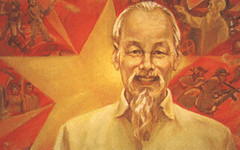
Socialist Realist depiction of the Vietnamese Revolutionary leader Ho Chi Minh. The Vietnamese defeated Japanese, French and American Imperialism during the 20th Century.
Originally uploaded by Pan-African News Wire File Photos
Reprinted from Wikipedia
PANW Editor's Note: Although this article does not recognize fully the contributions of socialist realist art forms, the underlying theme of working class and revolutionary culture as a by-product of anti-capitalist transformation still comes through the writings.
-----------------------------------------------------------------------------------------
The political aspect of socialist realism was, in some respects, a continuation of pre-Soviet state policy.
Censorship and attempts to control the content of art did not begin with the Soviets, but were a long-running feature of Russian life. The Tsarist government also appreciated the potentially disruptive effect of art and required all books to be cleared by the censor. Writers and artists in 19th century Imperial Russia became quite skilled at evading censorship by making their points without spelling it out in so many words. However, Soviet censors were not so easily evaded.
Socialist realism had its roots in neoclassicism and the traditions of realism in Russian literature of the 19th century that described the life of simple people. It was exemplified by the aesthetic philosophy of Maxim Gorki. The work of the Peredvizhniki ("Wanderers," a Russian realist movement of the late 19th / early 20th centuries), Jacques-Louis David and Ilya Yefimovich Repin were notable influences.
Characteristics of socialist realism
Socialist-Realist allegories surrounding the Palace of Culture and Science in Warsaw. Socialist realism held that successful art depicts and glorifies the proletariat's struggle toward socialist progress. The Statute of the Union of Soviet Writers in 1934 stated that socialist realism is the basic method of Soviet literature and literary criticism.
It demands of the artist the truthful, historically concrete representation of reality in its revolutionary development. Moreover, the truthfulness and historical concreteness of the artistic representation of reality must be linked with the task of ideological transformation and education of workers in the spirit of socialism.
Its purpose was to elevate the common worker, whether factory or agricultural, by presenting his life, work, and recreation as admirable. In other words, its goal was to educate the people in the goals and meaning of Communism.
The ultimate aim was to create what Lenin called "an entirely new type of human being": New Soviet Man. Stalin described the practitioners of socialist realism as "engineers of souls".
The "realism" part is important. Soviet art at this time aimed to depict the worker as he truly was, carrying his tools. In a sense, the movement mirrors the course of American and Western art, where the everyday human being became the subject of the novel, the play, poetry, and art.
The proletariat was at the center of communist ideals; hence, his life was a worthy subject for study. This was an important shift away from the aristocratic art produced under the Russian tsars of previous centuries, but had much in common with the late-19th century fashion for depicting the social life of the common people.
Painters would depict happy, muscular peasants and workers in factories and collective farms; during the Stalin period, they also produced numerous heroic portraits of the leader to serve his cult of personality.
Industrial and agricultural landscapes were popular subjects, glorifying the achievements of the Soviet economy. Novelists were expected to produce uplifting stories in a manner consistent with the Marxist doctrine of dialectical materialism. Composers were to produce rousing, vivid music that reflected the life and struggles of the proletariat.
Socialist realism thus demanded close adherence to party doctrine, and has often been criticized as detrimental to the creation of true, unfettered art – or as being little more than a means to censor artistic expression. Czesław Miłosz, writing in the introduction to Sinyavsky's On Socialist Realism, describes the products of socialist realism as "inferior", ascribing this as necessarily proceeding from the limited view of reality permitted to creative artists.
Not all Marxists accepted the necessity of socialist realism. Its establishment as state doctrine in the 1930s had rather more to do with internal Communist Party politics than classic Marxist imperatives. The Hungarian Marxist essayist Georg Lukács criticized the rigidity of socialist realism, proposing his own "critical realism" as an alternative. However, such critical voices were a rarity until the 1980s.
Notable works and artists of socialist realism Maxim Gorky's novel Mother is usually considered to have been the first work of socialist realism. Gorky was also a major factor in the school's rapid rise, and his pamphlet, On Socialist Realism, essentially lays out the needs of Soviet art. Other important works of literature include Fyodor Gladkov's Cement (1925) and Mikhail Sholokhov's two volume epic, And Quiet Flows the Don (1934) and The Don Flows Home to the Sea (1940).
The painter Aleksandr Deineka provides a notable example for his expressionist and patriotic scenes of the Second World War, collective farms, and sports. Yuri Pimenov, Boris Ioganson and Geli Korzev have also been described as "unappreciated masters of twentieth-century realism". Another well-known practitioner was Fyodor Pavlovich Reshetnikov.
Apart from obvious political considerations that saw works such as those of George Orwell being banned, access to foreign art and literature was also restricted on aesthetic grounds. Bourgeois art and all forms of experimentalism and formalism were denounced as decadent, degenerate and pessimistic, and therefore anti-Communist in principle. The works of James Joyce were particularly harshly condemned.
The net effect was that it was not until the 1980s that the general public in the Communist countries were able to freely access many works of Western art and literature. Many then joined Western observers in denouncing socialist realism as mere propaganda.
The Sots Art paintings of Komar and Melamid can be viewed as a parody of socialist realism.
No comments:
Post a Comment